Things to do in Marrakech
Marrakech is not just an ancient city in Morocco. It offers a sensory experience full of vibrant colors, flavors, smells, sounds, and unique sights. It is world-famous for its bustling markets and shopping in the Medina. Beyond that, there is so much to see and do in this historic place. The mix of European, Middle Eastern, and African cultures creates a truly unique atmosphere that’s hard to find elsewhere.
Marrakech was exactly as people described it: hot, dusty, and full of hassling. The main square, the Jemaa el Fna, had snake charmers and tourists everywhere, which added to its lively, chaotic charm. Despite these conditions, its a place anyone can love being there and feel a sense of connection to the place.
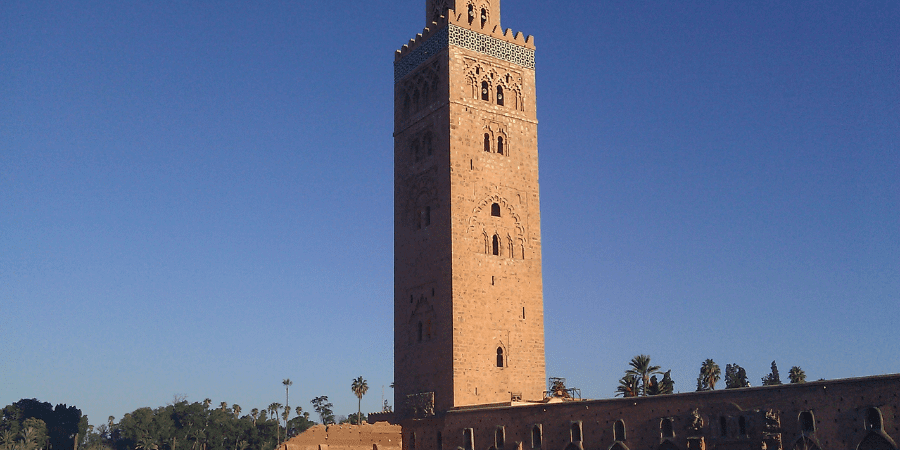
Walking through Marrakech gave me a deeper appreciation for its unique energy. Finding moments of solitude in such a busy city brought a different level of satisfaction. This city managed to meet and even exceed my expectations in ways I didn’t anticipate. Among all the places I visited in Morocco, Marrakech is the one I would most want to return to.
Spending two or three days in Marrakech is the perfect amount of time to explore its wonders and soak in the atmosphere. It’s an absolute must-visit destination on any Morocco itinerary. The mix of history, culture, and local experiences makes it unforgettable for travellers.
Historical and Cultural Significance
Marrakech is often referred to as the “Red City” due to its distinct terracotta-colored buildings. It holds a pivotal place in Moroccan history and culture. Founded in 1070 by the Almoravid dynasty, the city quickly rose to prominence as a key political, economic, and cultural hub in North Africa.
Its strategic location at the crossroads of ancient trade routes connected sub-Saharan Africa to Europe and the Mediterranean. This fosters a rich exchange of goods, ideas, and traditions.
1. Historical Milestones
- The Almoravid Dynasty: Marrakech was established as the capital of the Almoravid Empire, which laid the foundation for its architectural and cultural legacy. The Koutoubia Mosque, one of the city’s most iconic landmarks, reflects this era.
- The Saadian Golden Age: In the 16th century, the Saadian dynasty revived Marrakech as its capital, ushering in a golden age of art, architecture, and scholarship. They left behind magnificent structures such as the Saadian Tombs and El Badi Palace.
- French Protectorate Influence: In the early 20th century, Marrakech fell under French colonial rule, which introduced modern urban planning while preserving its historic medina.
2. Cultural Identity
Marrakech embodies a unique blend of Berber, Arab, and Andalusian influences, evident in its architecture, cuisine, and traditions. The city’s medina, a UNESCO World Heritage site, is a labyrinth of bustling souks, riads, and centuries-old landmarks. This encapsulates Morocco’s vibrant cultural tapestry.
3. Art and Architecture
- Islamic Artistry: Marrakech is renowned for its intricate tilework, calligraphy, and geometric designs. This can be found in structures like Ben Youssef Madrasa.
- Traditional Crafts: The city’s artisans have preserved centuries-old techniques in pottery, metalwork, and textiles which makes it a hub for traditional Moroccan crafts.
4. Festivals and Traditions
Marrakech plays host to numerous cultural festivals, such as the Marrakech International Film Festival and traditional moussem celebrations. This brings together local and international communities to celebrate Moroccan heritage.
5. Modern Cultural Renaissance
While rooted in history, Marrakech is also a modern cultural epicenter, attracting artists, writers, and designers from around the world. The Yves Saint Laurent Museum and contemporary galleries highlight this blend of past and present.
The historical and cultural significance of Marrakech makes it not just a tourist destination but a living museum of Moroccan heritage, where every corner tells a story of its illustrious past.
Exploring the Medina
#1. Djemaa el-Fna Square
The Djemaa el-Fna Square is the heart of the Medina in Marrakech, Morocco. Walking through this square is unlike anything else. Feel the heat coming from the stone floor as you pass by snake charmers, entertainers, and street food stalls offering fresh juices.
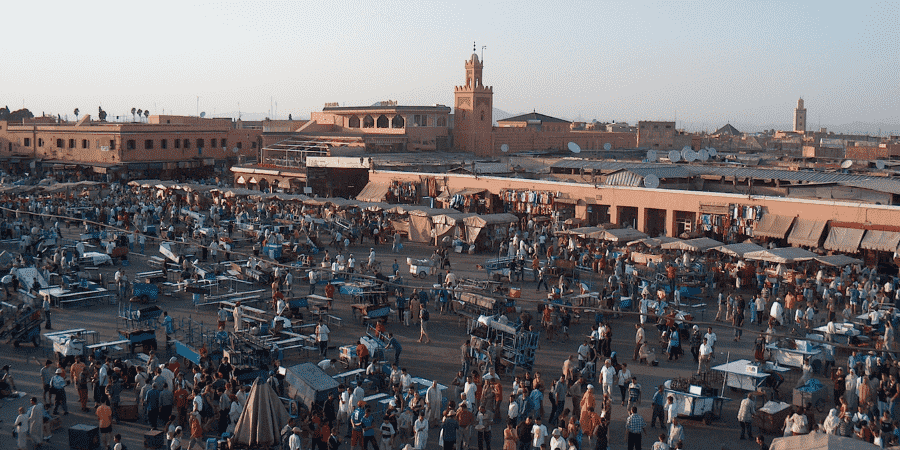
By night, the square transforms with music, flute players, dancers, and artists highlighting their talents under the twinkling lights. This lively scene captures the essence of Moroccan culture.
#2. Jemaa el-Fna Square
The Jemaa el-Fna Square is a must-visit attraction, despite not being my favorite spot in Marrakech. It is also near the Koutoubia Mosque, another essential site. The square is full of snake charmers, working donkeys, musicians, scammers, and artists who often seek to make a quick buck from tourists. It’s an incredible experience, but remember to stay vigilant and keep an eye on your belongings.
Tip: Pickpockets can be a problem, so stay cautious.
#3. Souks and Traditional Markets
If Jemaa el-Fna is the heart of Marrakech, then the souks are its true soul. Wander away from the main square and discover a maze of markets filled with vibrant sights and sounds. The covered markets and narrow, winding streets can be confusing, but this adds to their charm.
Enjoy the brilliant colors of the textiles, the magical smells of the spice-filled air, the high-quality leatherwork, and the twinkling lights bouncing off lanterns and colored glassware.
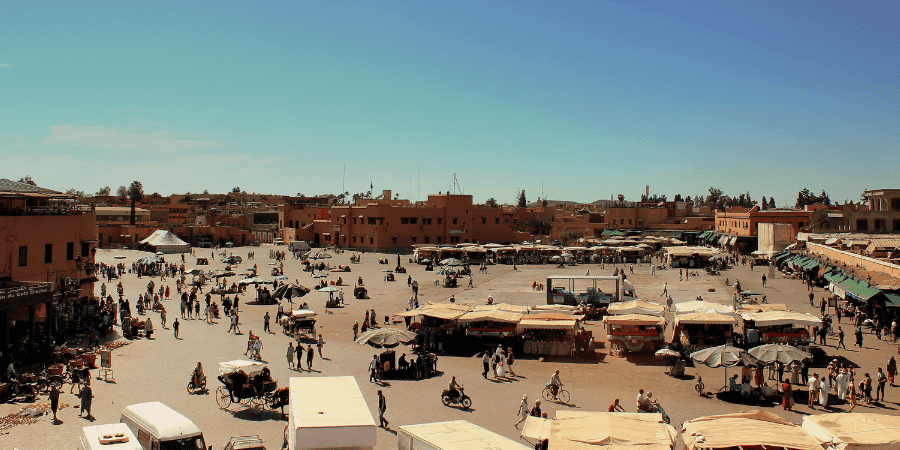
Visit Souk Semmarine, which is just off Jemaa el-Fna, and Souk Place des Epices, the traditional spice souk. Marrakech is the perfect place for shopping which offer everything from typical Moroccan items like carpets, Argan oil, and babouches to art, manuscripts, and carved doors.
The souks are vibrant and bustling, which makes them a must-visit for travellers. Be prepared to bargain it’s an essential part of the culture. Shopkeepers may try to persuade you to buy, so be firm but polite when declining. If you’re concerned about getting lost, consider hiring a reputable guide.
#4. Bahia Palace
Bahia Palace, which means ‘beautiful palace’. It was constructed in the late 19th century and stands as a cultural jewel in Marrakech. The decor is incredible, with gilded ceilings, paintings, mosaics, and stuccos throughout.
The open garden is a peaceful spot for visitors to wander through. The palace features 150 rooms, built by the grand vizier of the sultan, who wanted to create the most magnificent palace of all time.
The traditional Moroccan architecture is evident in the courtyards, which are adorned with fountains, orange trees, stained glass windows, and tilework. The most impressive feature is the luxurious marble courtyard at the center. Learning about the history of the grand vizier, his family, and his many wives is a unique experience.
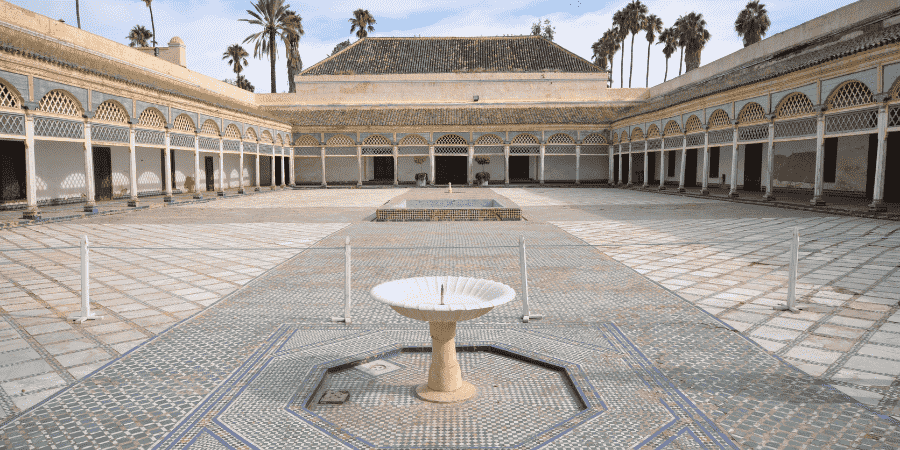
Note: Only part of the palace is open to the public, but it’s worth visiting, especially since it’s only a 20-minute walk from Jemaa el-Fna Square. It’s open daily from 8 AM – 5 PM.
#5. Saadian Tombs
The mausoleum is dedicated to Saadian Sultan Ahmed al Mansour ed-Dahbi and about two hundred of his closest people. The relaxing nature of the place cannot be overstated, offering a serene atmosphere.
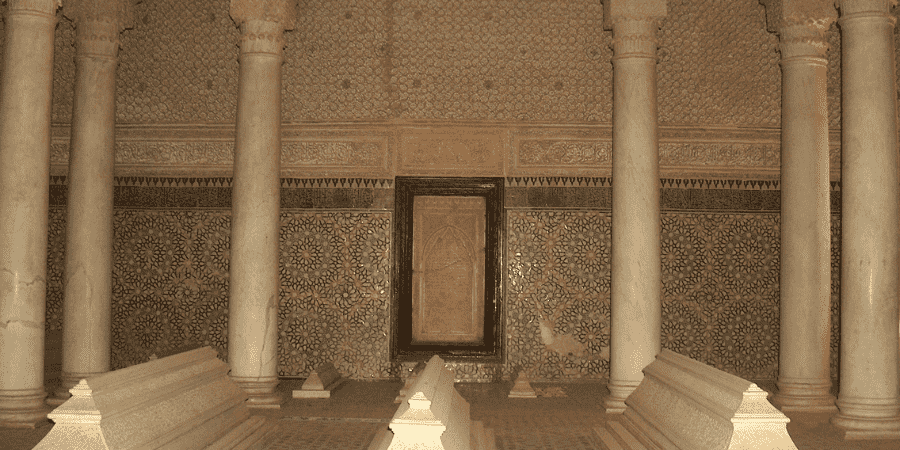
Architectural and Historical Highlights
#6. Koutoubia Mosque
The Koutoubia Mosque in Marrakech is a stunning symbol of the city’s Islamic heritage and an example of remarkable architecture. Built in the 12th century, its Minaret de la Koutoubia inspired the famous bell tower in Seville, Spain. The minaret’s beauty is undeniable, though non-Muslims cannot enter the mosque itself.
It’s worth visiting to admire its details and relax in the nearby Lalla Hasna Park. Standing just 200 meters from Jemaa el-Fna, the minaret of the mosque, which rises 77 meters, is visible from many points in the square.
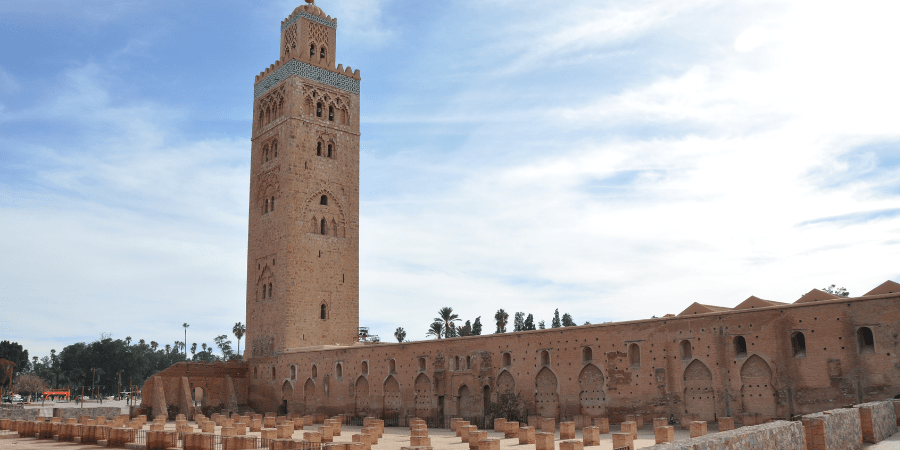
The Koutoubia Mosque has an interesting story: the current mosque is known as the “Second Koutoubia” built over or adjacent to the first one. The original mosque was built in 1147, and the current structure between 1158 and 1195. For a while, both mosques stood side by side until the first was dismantled and forgotten until 1923 excavations revealed some remains. Tourists, unless Muslim, can only explore the outdoor gardens and grounds.
#7. El Badi Palace
El Badi Palace, meaning “The Incomparable,” was commissioned by Sultan Ahmed al-Mansour in the late 16th century to celebrate his victory at the Battle of the Three Kings. This grand palace was built using luxurious materials such as Italian marble, gold from Sudan, and Indian onyx.
It symbolized the Saadian dynasty’s power and wealth. Now in ruins, the palace still exudes grandeur. The vast courtyard features sunken gardens filled with orange trees, while the towering walls and ramparts hint at the architectural brilliance of that era. Visitors can climb the walls for panoramic views of the medina and beyond.
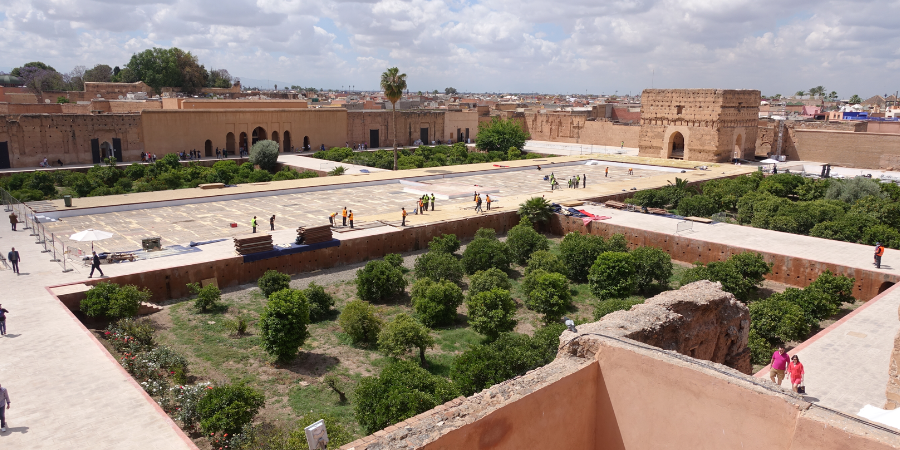
This offers a breathtaking connection between the past and the present. The palace houses the Koutoubia Minbar, a masterpiece of 12th-century Islamic art crafted from cedarwood inlaid with ivory and precious metals. Even in its current state, El Badi Palace invites visitors to imagine its former glory and marvel at the legacy of Moroccan dynasties.
#8. Ben Youssef Madrasa
The Ben Youssef Madrasa is a major highlight of Marrakech and one of the most visited sites after Jemaa el-Fna. This historic Koranic school is renowned for its extraordinary craftsmanship. It is advisable to arrive early to avoid crowds and capture the best pictures before the sun hits. Located near the medina, Ben Youssef was once the largest Islamic college in Morocco.
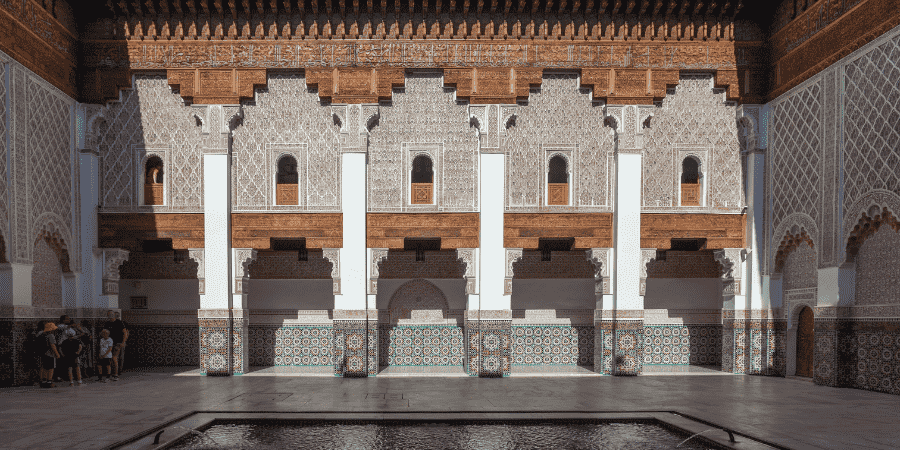
Spend time exploring its stunning architecture, especially the central terrace with a serene pool which is surrounded by intricate mosaics and cedarwood ceilings. The madrasa underwent a meticulous five-year renovation, restoring the elaborate zellij tiling and stuccowork.
The dormitories feature videos about this restoration which give insight into the skill of Moroccan craftsmen. This school is a testament to the technical brilliance and creative power of the master artisans of Morocco.
#9. Menara Gardens
The Menara Gardens are a serene oasis located just outside the bustling center of Marrakech. They offer a tranquil escape from the city’s vibrant energy. Established in the 12th century during the Almohad dynasty, the gardens were originally designed as an agricultural site.
This was done to provide a reliable water source for olive groves and fruit orchards. Over the centuries, the gardens evolved into a symbol of harmony, blending natural beauty with architectural elegance.
What to Expect
The centerpiece of the Menara Gardens is a large, reflective pool surrounded by neatly arranged olive trees. This was framed by the majestic Atlas Mountains in the distance. The pool, which dates back to the gardens’ origins, is ingeniously fed by a centuries-old underground irrigation system that brings water from the mountains.
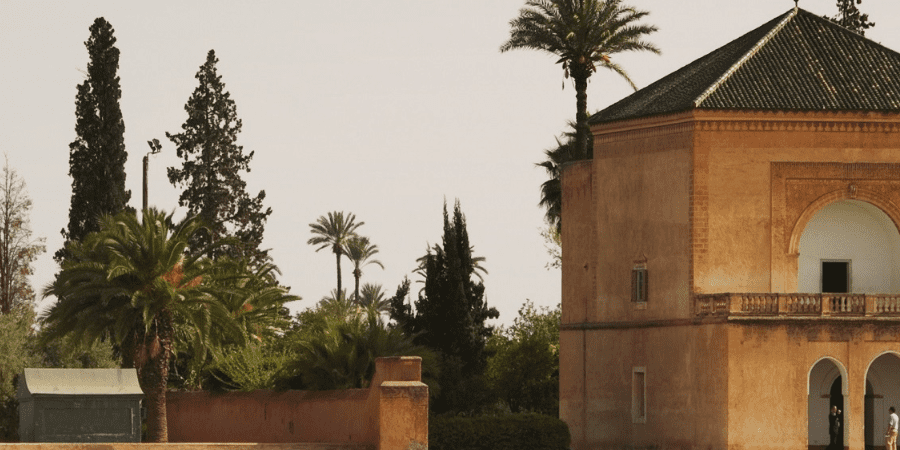
At one end of the pool stands the iconic pavilion, a 19th-century addition commissioned by Sultan Abderrahmane. This pavilion, with its simple yet elegant design, serves as a tranquil spot to admire the gardens. This is one of the favorite locations for photographers.
Why Visit?
- Natural Beauty: The lush greenery and serene ambiance of the Menara Gardens make it an ideal spot for leisurely strolls or peaceful contemplation.
- Architectural Charm: The pavilion and waterworks reflect the blending of functional engineering and artistic design typical of Moroccan heritage.
- Cultural Insight: The gardens offer a glimpse into traditional agricultural practices and the importance of sustainable water management in Morocco’s history.
- Picturesque Views: On clear days, the contrast between the gardens’ greenery and the snow-capped Atlas Mountains is truly breathtaking.
Things to Know
The Menara Gardens are best visited in the early morning or late afternoon when the light is soft and the atmosphere is most tranquil. It’s also a great place to relax with a picnic or simply enjoy the quiet beauty away from the vibrant medina of the city.
#10. Palmeraie Oasis
The Palmeraie Oasis, located on the outskirts of Marrakech, is a vast stretch of over 100,000 palm trees spread across more than 13,000 hectares. Often referred to as the “green lung” of the city, this lush oasis has been a symbol of Marrakech’s historical connection to agriculture. It offers a striking contrast to the bustling medina and arid surroundings.
What to Expect
The Palmeraie is a tranquil haven where visitors can explore winding paths shaded by towering palm trees. It is not just a natural retreat but also a hub for luxury resorts, golf courses, and private villas, making it a blend of natural beauty and modern indulgence.
One of the most popular activities in the Palmeraie is taking a leisurely camel ride or a quad bike tour through its scenic expanse. These experiences allow visitors to soak in the serene environment while enjoying a taste of traditional Moroccan culture and adventure.
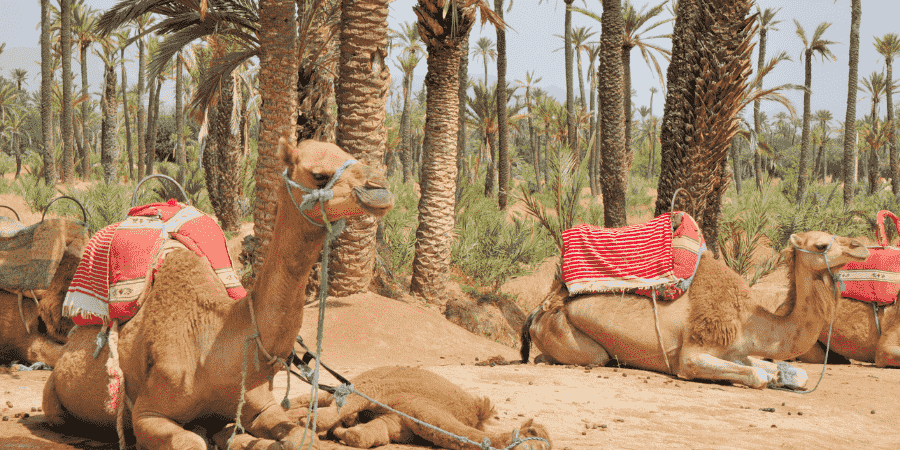
Why Visit?
- Historical Significance: The Palmeraie was established during the Almoravid dynasty. It showcases ancient irrigation techniques that sustained this green expanse in the desert environment.
- Natural Beauty: With its iconic palm groves, the oasis offers an idyllic setting for relaxation and exploration.
- Recreational Activities: From camel rides to quad biking, the Palmeraie provides unique ways to enjoy its landscape.
- Luxury and Leisure: Many upscale resorts and spas in the area offer a blend of comfort and local charm for those seeking a retreat.
Things to Know
The Palmeraie is easily accessible from Marrakech and is best explored in the cooler hours of the day to avoid the midday heat. Guided tours are available to explain the oasis’s ecological and cultural importance.
Whether you’re seeking adventure, relaxation, or a glimpse into Marrakech’s agricultural heritage, the Palmeraie Oasis is a must-visit destination.
Cultural Experiences
#11. Traditional Moroccan Hammams
The hammam is an essential part of Moroccan culture, with one found in nearly every neighborhood in Marrakech. These public bathhouses serve as a place for the gommage (body scrub) and are where Moroccans go weekly to unwind and socialize with friends and family.
Visiting a traditional hammam offers a unique opportunity to experience Moroccan life firsthand and this is incredibly restorative for both body and mind. Most hammams provide more than just a scrub; many include soothing masques and massages to enhance relaxation.
Why visit?
To have an authentic, immersive experience. Local hammams are inexpensive and provide a true taste of Moroccan tradition. However, tourists should be prepared: these hammams don’t cater specifically to visitors, so you’ll need to bring items like soap, a mitt, and a bucket. It can also be challenging to communicate due to language barriers, but the experience is worthwhile.
Westernised Hammams
Westernised hammams are available for those who prefer a more modern, spa-like experience. These pampering services are similar to those found in high-end spas. Hammam de la Rose is an excellent example, offering a variety of treatments in a serene and calming environment.
The focus here is on well-being and health, making it a perfect choice for those looking for a tranquil escape. Prices are reasonable for the quality of service offered, making it a standout option for a luxurious yet affordable experience.
Local Festivals and Events
Marrakech is a city of vibrant celebrations deeply rooted in its cultural and historical traditions. Throughout the year, the city hosts a variety of festivals and events that showcase its artistic, religious, and community spirit. These gatherings provide a unique opportunity to experience the heart and soul of Marrakech, where music, art, and traditions come to life.
1. Marrakech International Film Festival
- When: Usually held in December
- What: One of the most prestigious film festivals in Africa. This event attracts filmmakers, actors, and cinema enthusiasts from around the world. Screenings take place in iconic venues like the Palais des Congrès and open-air theaters in the medina.
- Why Visit: It’s a fantastic opportunity to witness global cinematic talent while soaking in the cultural ambiance of Marrakech.
2. Djemaa el-Fna Evening Performances
- When: Every evening
- What: While not a traditional “festival,” the nightly performances at Djemaa el-Fna Square feel like a celebration. Storytellers, acrobats, musicians, and snake charmers transform the square into a vibrant, open-air theater.
- Why Visit: This UNESCO-recognized cultural space is a living testament to the artistic heritage of the city.
3. Eid al-Adha (Festival of Sacrifice)
- When: Dates vary based on the Islamic lunar calendar
- What: One of the most important religious celebrations in Morocco. Eid al-Adha is marked by prayers, feasts, and acts of charity.
- Why Visit: Witness the deep spiritual and communal aspects of Moroccan culture during this significant festival.
4. Marrakech Popular Arts Festival
- When: July (dates may vary)
- What: This colourful event celebrates traditional Moroccan arts. This includes music, dance, and storytelling. Performances are held in historic venues such as El Badi Palace, which adds to the festival’s charm.
- Why Visit: Experience Morocco’s diverse cultural heritage in an immersive setting.
5. Moussem Festivals
- When: Various times of the year
- What: These traditional religious and community festivals honor saints or mark important agricultural milestones. In Marrakech and its surroundings, moussem celebrations often include processions, music, and communal meals.
- Why Visit: Moussem festivals provide a unique glimpse into the spiritual and communal life of Moroccan society.
Day Trips and Excursions
Atlas Mountains
The Atlas Mountains offer a spectacular day trip just an hour or two from Marrakech. This stunning mountain range is known for its lush valleys, jagged peaks, and cooler climate. This provides an incredible contrast to the vibrant energy of the city.
Exploring the mountains means enjoying the natural beauty of Morocco and visiting the breathtaking Ourika or Imlil Valleys. Along the way, you’ll pass through traditional Berber villages where you can experience local life, sample authentic Moroccan dishes, and learn about the community’s unique heritage.
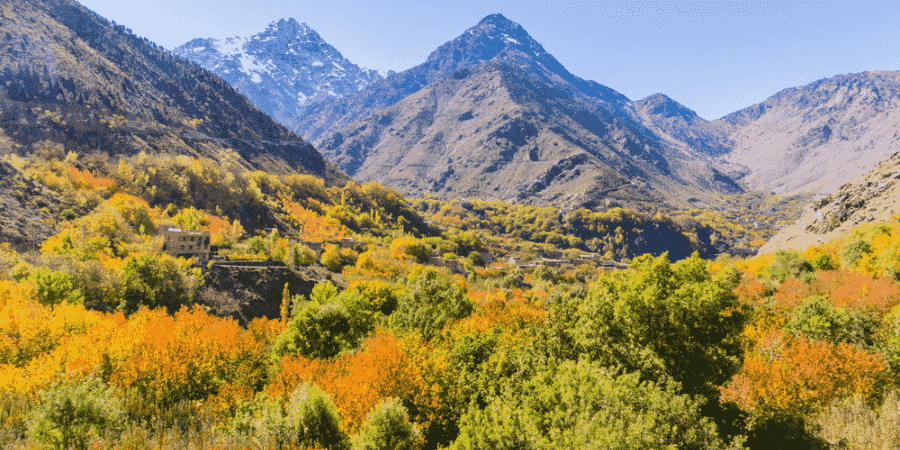
A trip to the Atlas Mountains is perfect for both nature enthusiasts and those interested in cultural experiences. The scenic trails and panoramic views offer plenty of opportunities for photography and hiking.
For winter visitors, the Atlas Mountains are also a hidden gem for skiing. During the warmer months, the evenings can get surprisingly cool. So, it’s wise to pack an extra layer to stay comfortable while enjoying the sunset views over the mountains.
Ouzoud Waterfalls
The Ouzoud Waterfalls are the tallest in Morocco and a popular day trip destination from Marrakech. Over two and a half hours away by car, they offer a perfect escape from the hustle and bustle of the city. The drive to the falls is scenic and sets the stage for an unforgettable experience.
The waterfalls cascade over a height of 110 meters in a series of seven distinct levels which creates an impressive sight. While the water doesn’t free-fall, it flows through each level in a mesmerizing display of nature’s power.
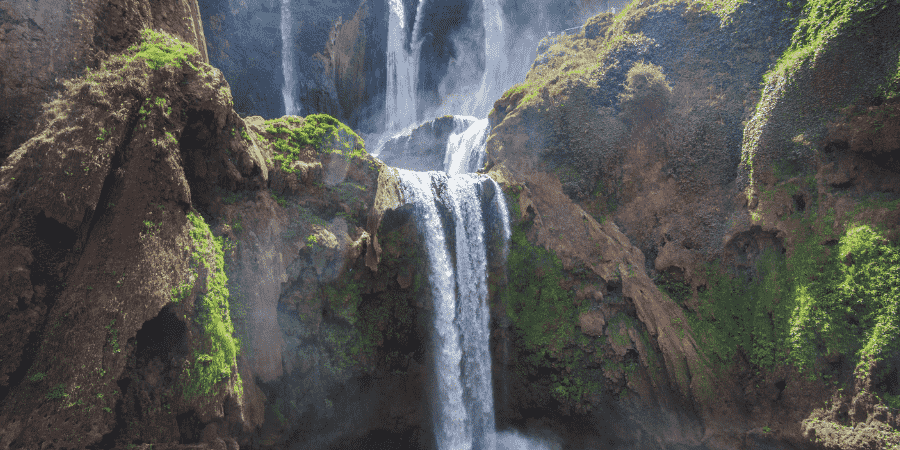
The first waterfall, closest to the village of Tanaghmeilt, is the easiest to access and offers incredible views. The water here is sourced from the High Atlas Mountains, feeding into the fertile Ourika Valley before joining the Tensift River.
The Ouzoud Waterfalls are surrounded by a semi-developed area that caters to tourists. The lower part near the village has various restaurants, accommodations, and small shops. This makes it easy to spend the day enjoying the natural beauty and amenities. Whether you want to explore the hiking trails, snap photos of the breathtaking views, or have a leisurely meal by the falls. Ouzoud offers a refreshing day out for visitors of all kinds.
Dining and Nightlife
Traditional Moroccan Cuisine
Exploring Moroccan cuisine is a must for any visitor to the country which offers an explosion of flavors and aromas that are as vibrant as the culture itself. The rich history of Morocco and its geographic location have influenced its culinary traditions, resulting in a cuisine that blends Berber, Arab, Mediterranean, and French influences. Below are some quintessential dishes and drinks to try:
Mint Tea
A true staple in Moroccan culture, mint tea is more than just a beverage; it’s an essential social ritual. Brewed using gunpowder tea and fresh spearmint leaves, it’s sweetened generously with sugar. The result is a refreshing, slightly bitter, and very sweet tea that is served throughout the day, often ceremoniously to guests.
Shakshuka (Berber Omelette)
This popular dish consists of poached eggs in a tomato sauce enriched with peppers, garlic, onions, and spices like cumin, paprika, and cayenne. It is common across North Africa and the Middle East and is typically enjoyed as a hearty breakfast or brunch.
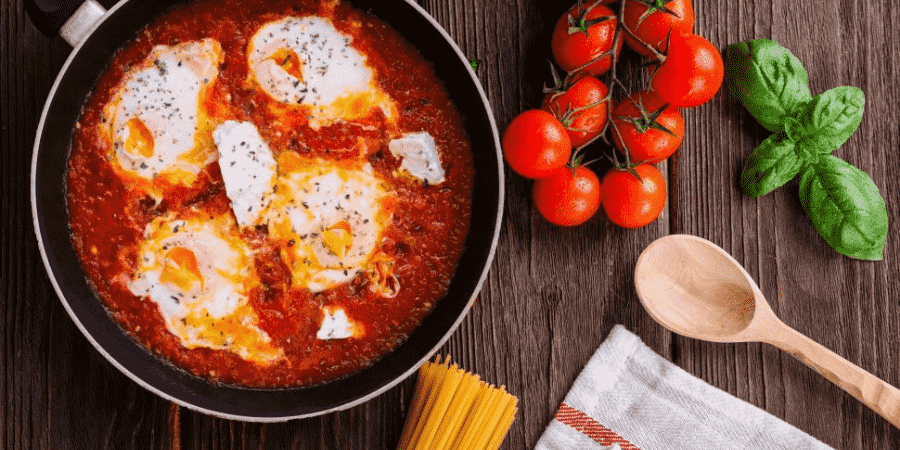
Variations may include preserved lemons, olives, and even cheese. This makes it a versatile and flavorful dish.
Taktouka
Taktouka is a Moroccan salad similar to shakshuka but without eggs. It’s made from roasted tomatoes, bell peppers, olive oil, and spices. It’s a side dish or dip served with bread and pairs well with grilled meats and fish. It’s a lighter and milder option which is perfect for those looking to sample something fresh and tangy.
Kefta & Kefta Tagine
Kefta consists of spiced minced meat (usually beef or lamb) mixed with cilantro, onions, lemon juice, and cumin. The meat is shaped into patties or skewers and grilled or broiled.
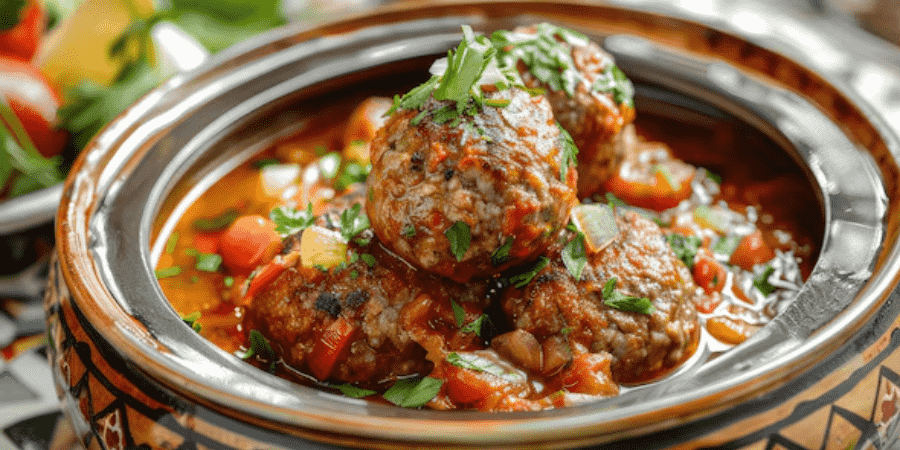
Kefta tagine takes this to the next level, baking the meatballs in a tomato-based sauce similar to shakshuka, often with eggs poached directly in the sauce. It’s commonly served with bread or rice.
Kebabs (Brochette)
Skewered meat, known as brochette, is a popular dish throughout Morocco. It is typically made with lamb or beef. The meat is marinated with parsley, onions, olive oil, and spices like black pepper and salt and then grilled over charcoal. These kebabs are tender, smoky, and juicy and are often served with vegetables and flatbread.
Bastilla (Pastilla)
Bastilla, a dish of Andalusian origin, is a savoury-sweet pastry that is a signature of Moroccan cuisine. Traditionally made with pigeons, modern versions use chicken. The filling includes meat browned with butter, simmered with parsley, onions, and warm spices such as saffron, nutmeg, and ginger.
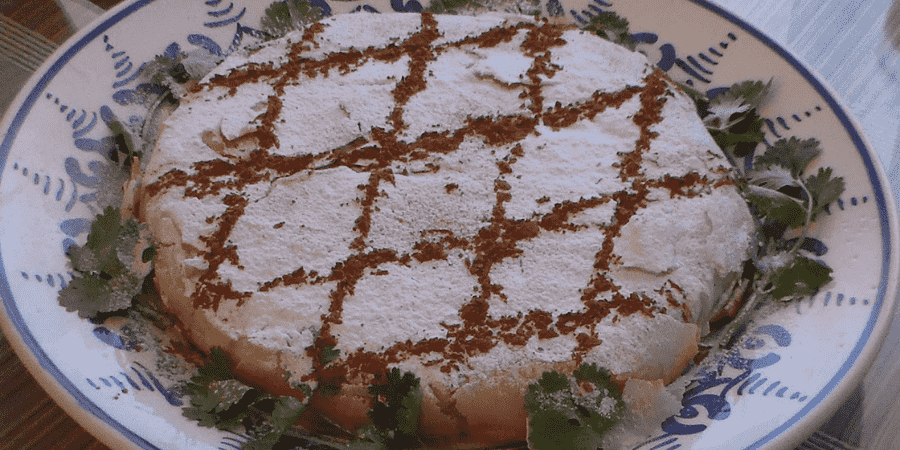
This mixture is then enveloped in thin, flaky warqa dough and topped with fried almonds, cinnamon, and powdered sugar. It’s a unique combination of savory and sweet flavors that is visually striking and incredibly tasty.
Moroccan cuisine, with its extensive use of spices like cumin, cinnamon, turmeric, and saffron, offers a sensory journey that reflects a nation’s rich culture and history. Each dish, whether a street food snack or a multi-layered tagine, showcases the skill and tradition of Moroccan cooking, promising an experience that you can’t replicate anywhere else.
Rooftop Cafés and Restaurants
Explore the best rooftop spots in Marrakech which offers stunning views, delicious food, and an unforgettable ambiance:
1. Nomad
- Why Visit: A chic rooftop offering modern Moroccan dishes with a contemporary twist.
- Highlights: Panoramic views of the medina and a stylish, relaxed atmosphere.
2. Café des Épices
- Why Visit: It is located in the heart of the spice market; this café serves traditional Moroccan tea and light bites.
- Highlight: Overlooks the vibrant souks and is perfect for people-watching.
3. Le Jardin
- Why Visit: A lush, green oasis with a rooftop terrace serving Moroccan and international cuisine.
- Highlight: Beautiful garden vibes and views of the old medina.
4. La Pergola
- Why Visit: A trendy spot near Koutoubia Mosque with a diverse menu, including vegetarian options.
- Highlight: It provides great views of the mosque and the bustling streets below.
5. Kosybar
- Why Visit: Known for its cozy ambiance and excellent cocktails, this rooftop overlooks the El Badi Palace.
- Highlight: Best spot for a sunset view with a drink in hand.
6. Café Clock
- Why Visit: Famous for its camel burger and relaxed atmosphere with cultural performances and workshops.
- Highlight: Combines great food with unique local experiences.
7. El Fenn Rooftop
- Why Visit: A luxury spot offering gourmet food and a rooftop pool with stunning city views.
- Highlight: Perfect for a special occasion or a sophisticated evening out.
These rooftop cafés and restaurants offer incredible food and provide the perfect vantage point to soak in the charm and energy of Marrakech.
Best Time to Visit
Marrakech is a year-round destination, but the best time to visit depends on your preferences for weather and activities. Here’s a breakdown to help you plan:
Spring (March to May)
- Why Visit: The weather is warm but not overly hot, with daytime temperatures averaging 20–25°C (68–77°F). The city is alive with blooming flowers which makes it perfect for outdoor exploration.
- Highlights: Ideal for visiting gardens like Jardin Majorelle or taking day trips to the Atlas Mountains and surrounding valleys.
Autumn (September to November)
- Why Visit: Like spring, the weather is pleasant, with mild evenings and sunny days. This is a great time to enjoy the city without the peak summer heat.
- Highlights: This is perfect for strolling through the medina, exploring historical sites, and rooftop dining under clear skies.
Winter (December to February)
- Why Visit: Days are mild, with temperatures around 18–20°C (64–68°F), but evenings can be chilly. This is the best time for budget travellers, as it’s the low season for tourism.
- Highlights: Enjoy fewer crowds and a cozy experience in traditional riads. The snow-capped Atlas Mountains add a scenic touch to the surroundings.
Summer (June to August)
- Why Visit: Temperatures can soar above 40°C (104°F), but this is the least crowded season, and hotel rates are often lower.
- Highlights: Focus on indoor activities like visiting palaces and museums, and take advantage of cooler evenings for exploring the night markets.
General Tips
- Festivals and Events: For a unique cultural experience, plan your visit around events like the Marrakech International Film Festival in December or the Marrakech Popular Arts Festival in July.
- Day Trips: If you visit in summer, consider trips to the cooler Atlas Mountains or coastal cities like Essaouira.
- Packing: Bring layers, especially if visiting in winter or for evenings in spring and autumn.
Transportation in Marrakech
Marrakech is a city with diverse transportation options, each suitable for different needs and preferences. Here’s an overview of the various ways to get around:
1. Walking
The most convenient way to navigate the medina, the historical heart of Marrakech, is on foot. The narrow alleyways are too tight for most vehicles, making walking essential for exploring the souks, markets, and landmarks. Be vigilant, as motorbikes and scooters often share these paths and can move at high speeds.
2. Bikes and Scooters
Cycling and scooter rentals are available for those looking to travel more quickly or explore areas outside the medina. While this can be an enjoyable way to see the city, exercise caution as these vehicles can be fast-moving, especially in busy parts.
3. Local Buses
Marrakech’s ALSA bus network offers both regular and electric buses that are inexpensive (around 4 dirhams per trip). However, these buses are older and often crowded, which makes them less appealing for tourists compared to other options.
4. Taxis
Marrakech has two types of taxis:
- Petit Taxis are smaller vehicles used for travel within the city. They are ideal for short distances and can accommodate up to three passengers.
- Grand Taxis: Larger vehicles designed for longer trips, including excursions outside the city.
Taxis in Marrakech are equipped with taximeters, but drivers may sometimes “forget” to turn them on. Before starting your ride, ensure the meter is activated or agree on a fare beforehand. If a driver refuses, it’s best to find another taxi.
Airport Transfer: From Marrakech-Menara Airport (about 3 km from the city center), you have two main options:
- ALSA shuttle bus (line 19), running from 6 a.m. to 9:30 p.m., at a cost of 30 dirhams per ride. Buses run approximately every 20 minutes.
- Taxis, available at the airport 24/7. Regulated fares are displayed at the airport and cost 70 dirhams during the day and 100 dirhams at night for a trip to the city center. Negotiating fares for other trips is often possible.
5. Car Rentals
Renting a car is recommended if you plan to stay in areas like the Palmeraie or wish to take day trips outside Marrakech. Multiple car rental agencies operate in the city, including international brands like Hertz, Sixt, Avis, and Europcar, as well as local companies offering quality service. Expect to pay around 30 euros per day for a basic car rental.
Key Tips:
- Medina Travel: The medina can only be explored on foot, as the streets are too narrow for cars.
- Safety Alert: Watch out for fast-moving scooters and bikes in busy areas.
- Negotiate Taxi Fares: Always confirm or negotiate the fare before starting your journey to avoid unexpected costs.
With these transportation options, getting around Marrakech is manageable, whether you’re exploring the medina or venturing further afield.
Final Thoughts
A must-see location, Marrakech provides a mesmerizing fusion of lively souks, ancient sites, and tranquil gardens. As you discover its allure, think about include Uzbekistan on your itinerary. Discover the Top Places to Visit in Uzbekistan for a once-in-a-lifetime experience exploring its fascinating history, breathtaking architecture, and distinctive cultural legacy. Both locations provide amazing experiences that combine beauty and heritage.

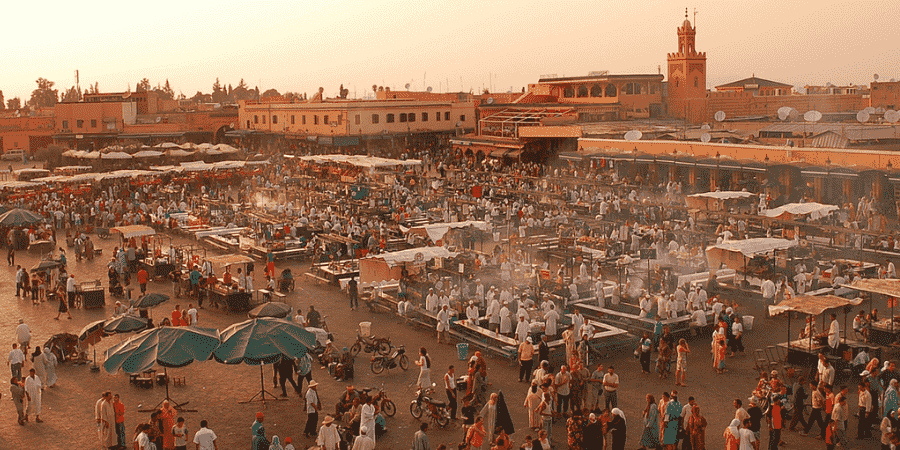
No responses yet